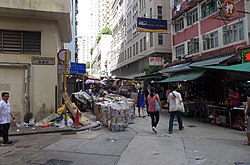Draft:Cross Street (Hong Kong)
| This is a draft article. It is a work in progress open to editing by anyone. Please ensure core content policies are met before publishing it as a live Wikipedia article. Find sources: Google (books · news · scholar · free images · WP refs) · FENS · JSTOR · TWL Last edited by Onel5969 (talk | contribs) 3 seconds ago. (Update)
Finished drafting? or |
The topic of this draft may not meet Wikipedia's notability guideline for geographic features. (April 2025) |

Cross Street (Chinese: 交加街) is a street and street market (open-air bazaar) in the Wan Chai District of Hong Kong Island, Hong Kong.[1][2] It runs east-west, between Johnston Road and Queen's Road East. Cross Street connects Spring Garden Lane in the west to Wan Chai Road in the east. The streets that pass through the middle are Tai Yuen Street and Stone Nullah Lane (north segment). Cross Street is located in the city center of Wan Chai. Both sides of the street are lined with hawker stalls and vehicles are not allowed to enter.
With the development of the urban area, open-air street markets in Hong Kong have gradually disappeared, and there are not many street marketsleft on Hong Kong Island.[2][3] Cross Street is one of them. It is a typical street market in the old district of Wan Chai with a history of about 80 years.[4] The street market in Cross Street (and Tai Yuen Street) was the filming location of the famous movie "The World of Suzie Wong" (蘇絲黃的世界).[5]
Some of the hawker stalls have been operating at Cross Street for more than 70 years, serving the local community. For the local community, the street market is more than just a place to buy daily necessities. It is a favorite gathering place and an important hub for social interaction.[2] For this reason, when the government proposed in 2006 to relocate more than 80 fixed street market hawker stalls to a newly built Wan Chai market nearby, community members including hawkers, relevant concern groups and conservation organizations spoke out, arguing that this move would destroy local community and affect local economic activities.[2] In response to the call from the local community, the Hong Kong Development Bureau established the Old Wan Chai Revitalisation Scheme Special Committee (OWRISC) to explore ways to revitalize Old Wan Chai, including the Cross Street open-air bazaar.[6]
Features
[edit]Neighboring Streets
[edit]Photos
[edit]-
Silvervale Mansion, 18 Cross Street
-
Wan Chai Market (Cross Street Entrance)
-
Vegetable hawker stall on Cross Street
-
Flowers stall on Cross Street
-
Outdoor market on Cross Street
-
Fresh flowers selling on Cross Street
-
Fresh flowers stall on Cross Street
-
Large size clothes selling on Cross Street
-
Clothing stall on Cross Street
-
Sportswear on Cross Street
-
Stall selling eggs and dried foods
-
No vehicles allowed between 10am to 6pm
-
Road signs
-
Cross Street
-
Kuen Kee noodle shop on Cross Street
References
[edit]- ^ 潘國靈 (2006) 灣仔:香港微縮, Twenty-first Century Bimonthly, Research Centre for Contemporary Chinese Culture of The Chinese University of Hong Kong, April 2006.
- ^ a b c d Garcia-Holguera, Mercedes; Clark, Grant; Gaskin, Susan; Sprecher, Aaron (2013). "Ecosystems Biomimetics: Ecological Systems Diagrams for Characterization of Environmental Performance of Buildings". The International Journal of the Constructed Environment. 3 (2): 147–165. doi:10.18848/2154-8587/cgp/v03i02/37385. ISSN 2154-8587.
- ^ "Film Promotion and Facilitation Section - Location Library". fpf.ccidahk.gov.hk. Retrieved 2025-05-20.
- ^ 顏炳華(2007)灣仔舊區重建下的太原街露天市集的命運. Available at: https://www.history.cuhk.edu.hk/CourseWeb/201415/201415_hist5559/Final%20Report_Joesph.pdf
- ^ "灣仔歷史文物徑 舊日的足迹". 太陽報 (in Chinese (Hong Kong)). Retrieved 2025-05-20.
- ^ "Wan Chai Heritage Trail - Project - Heritage Preservation & Revitalisation - Urban Renewal Authority - URA". www.ura.org.hk. Retrieved 2025-05-20.
- ^ "Market". www.fehd.gov.hk. Retrieved 2025-04-07.
- ^ Cheapo, Hong Kong. "Wan Chai Wet Market". Hong Kong Cheapo. Retrieved 2025-04-07.
- ^ birth; expat, she grew up in Hong Kong as an; Frequently, Continues to Visit the City (2024-11-07). "Solo Traveller's Guide to Street Markets in Hong Kong: Which Ones to Visit and Which to Skip". Retrieved 2025-04-07.
- ^ "Hong Kong Fun in 18 Districts - Tai Yuen Street and Cross Street". www.gohk.gov.hk. Retrieved 2025-04-07.















